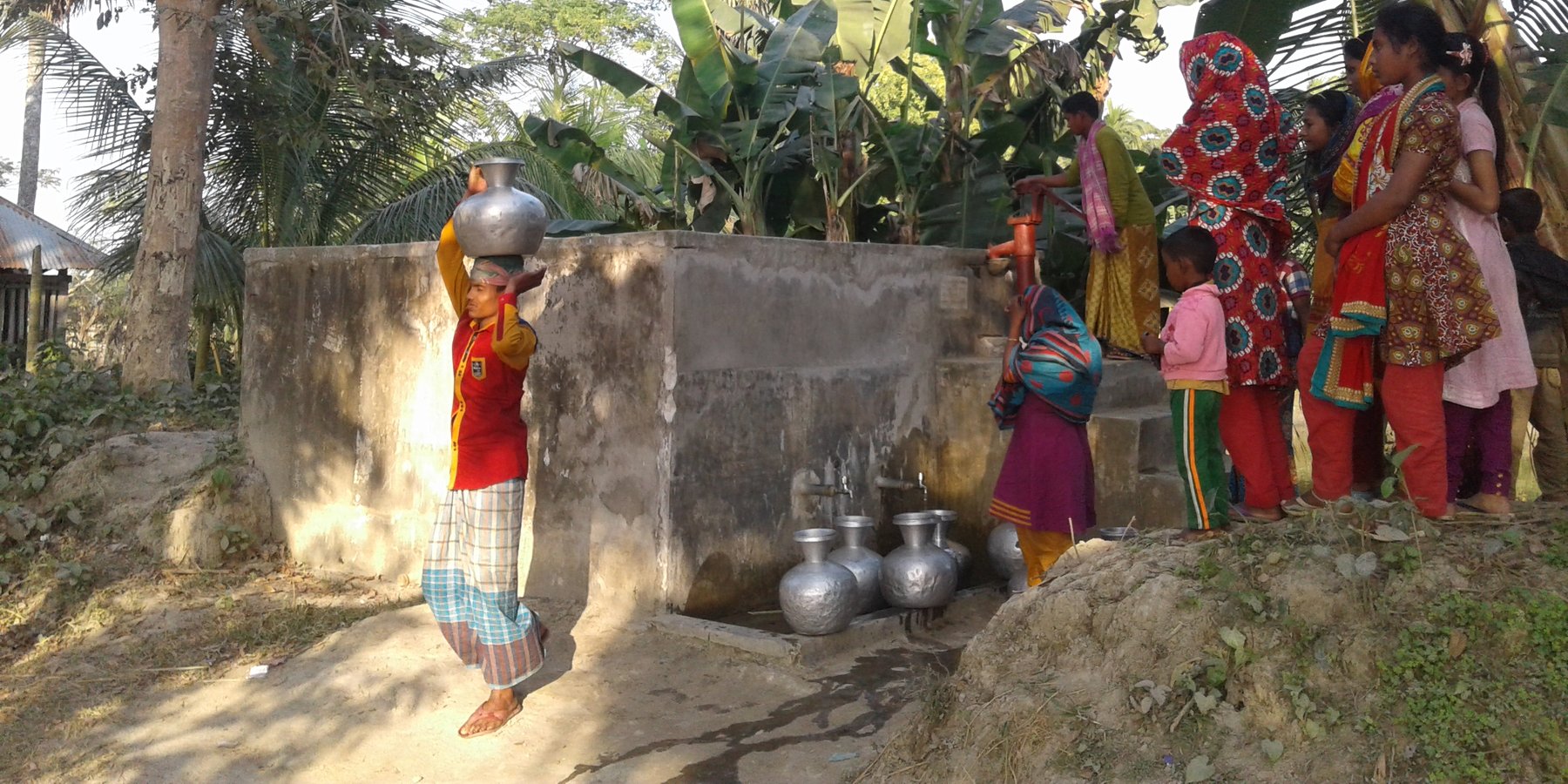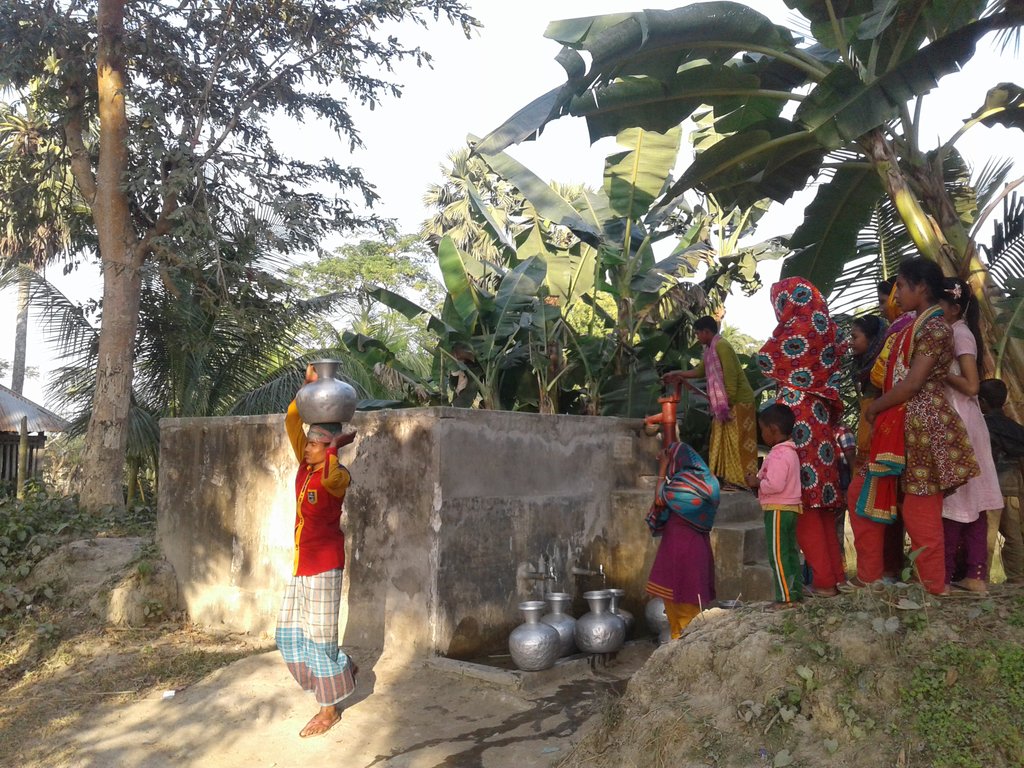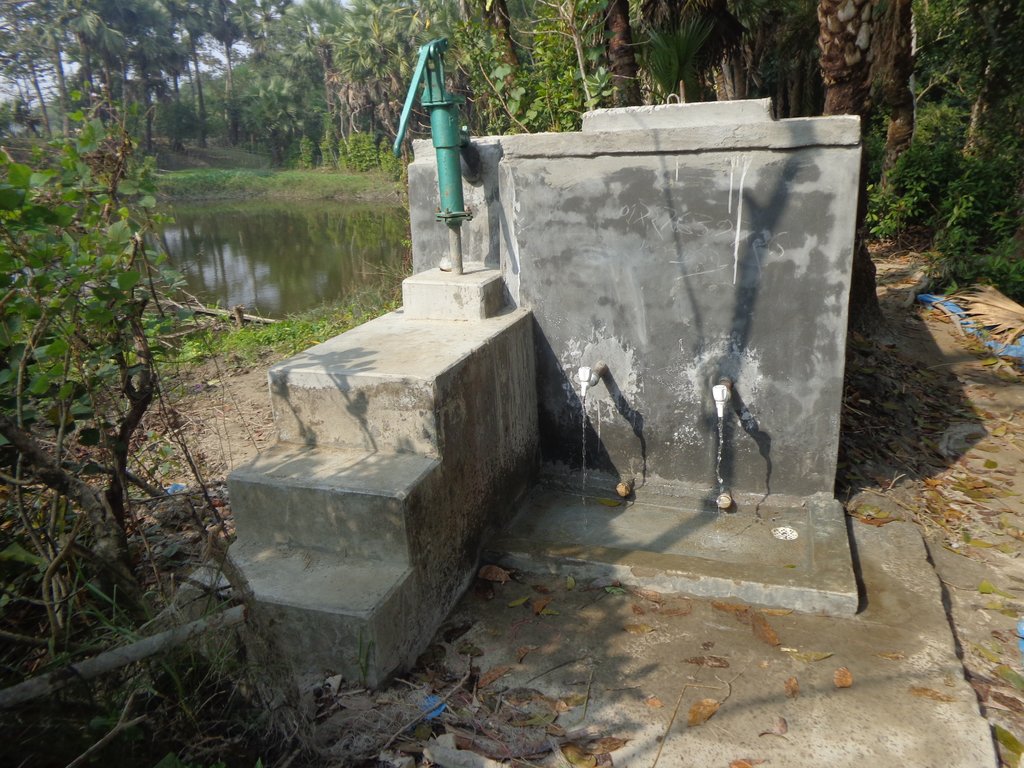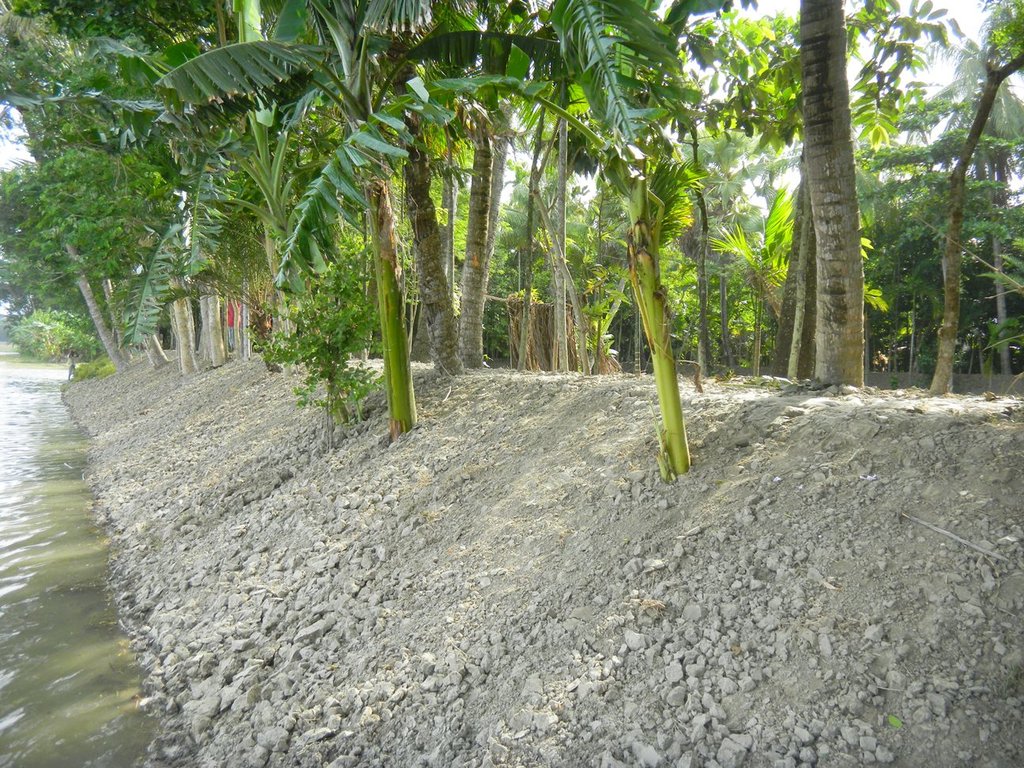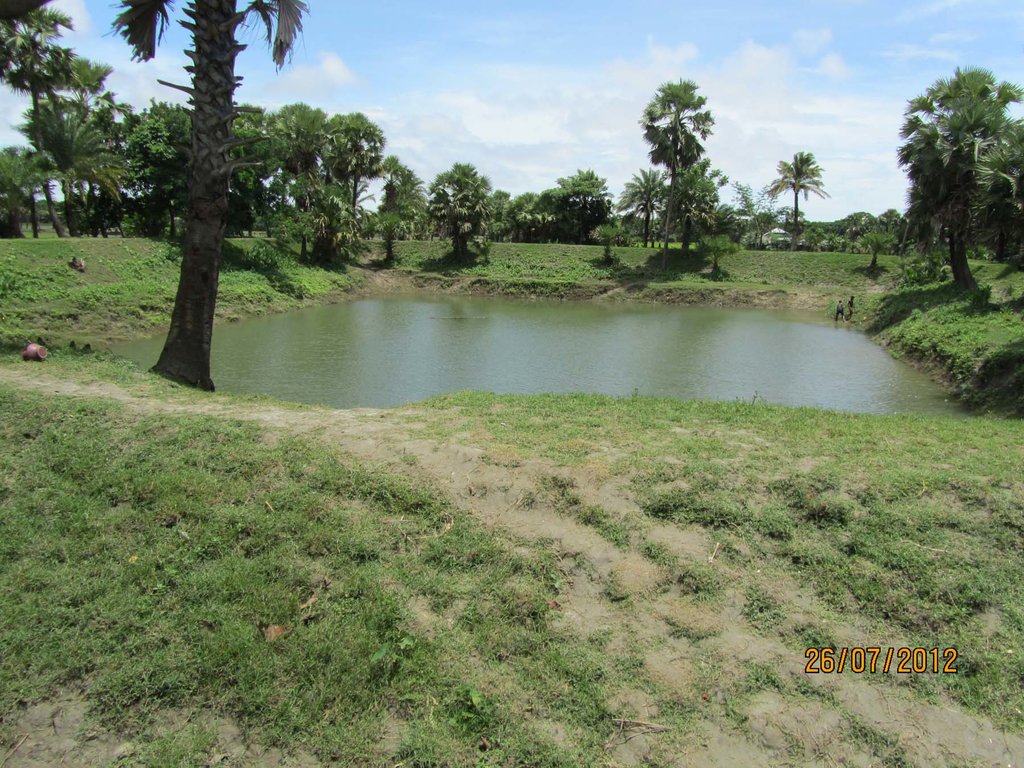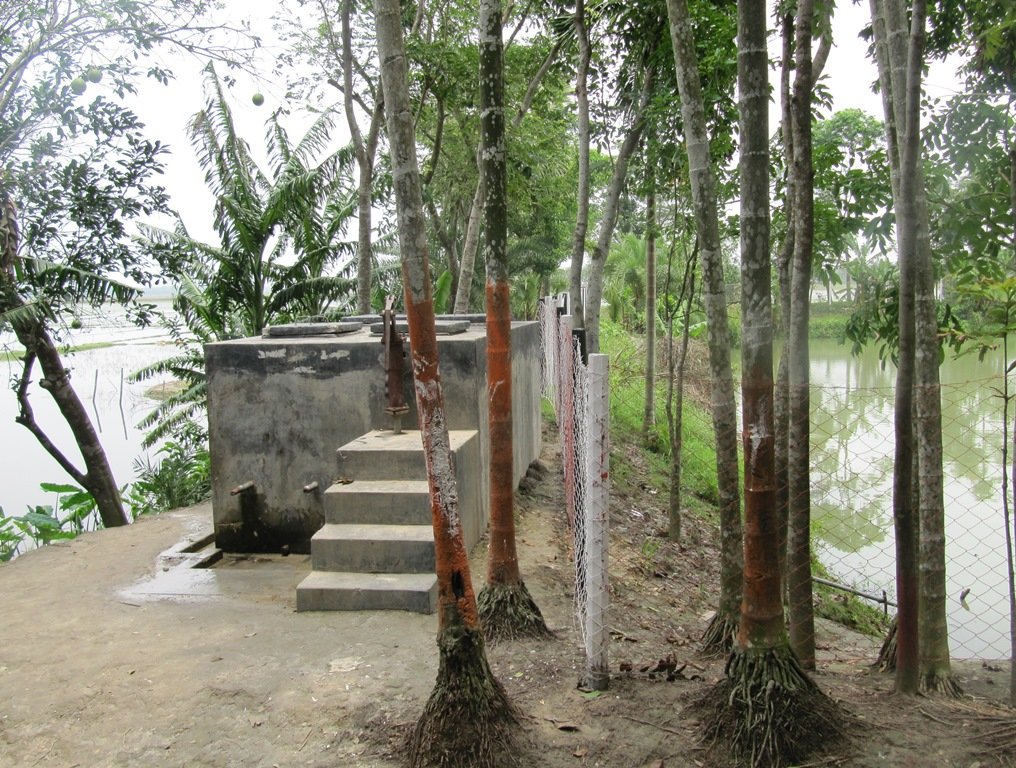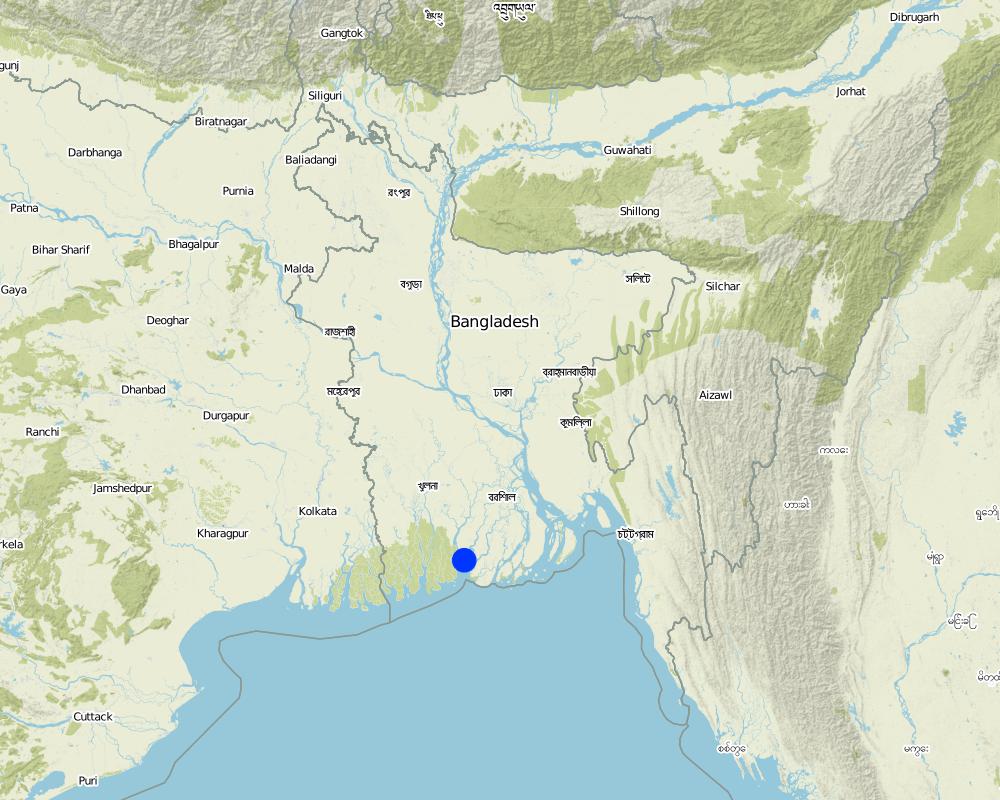Pond Sand Filter (PSF) with Raised Embankment [بنغلاديش]
- تاريخ الإنشاء:
- تحديث:
- جامع المعلومات: John Brogan
- المحررون: Shahid Kamal, Md. Rahmatullah Faruque
- المراجعون: Alexandra Gavilano, Hanspeter Liniger, Nicole Harari, Deborah Niggli
FILTER
technologies_550 - بنغلاديش
عرض الأقسام
توسيع الكل طي الكل1. معلومات عامة
1.2 تفاصيل الاتصال بالأشخاص الرئيسيين لمصدر المعلومات والمؤسسات المشاركة في تقييم وتوثيق التقنية
اسم المشروع الذي سهّل توثيق/تقييم التقنية (إذا كان ذلك على صلة)
Book project: where people and their land are safer - A Compendium of Good Practices in Disaster Risk Reduction (DRR) (where people and their land are safer)اسم المؤسسة (المؤسسات) التي سهلت توثيق/تقييم التقنية (إذا كان ذلك على صلة)
Terre des Hommes (Terre des Hommes) - سويسرا1.3 الشروط المتعلقة باستخدام البيانات الموثقة من خلال WOCAT
يوافق جامع المعلومات والشخص (لاشخاص) الرئيسي لمصدر المعلومات على الشروط المتعلقة باستخدام البيانات الموثقة من خلال WOCAT:
نعم
1.4 إعلان بشأن استدامة التقنية الموصوفة
هل التقنية الموصوفة هنا تمثل مشكلة فيما يتعلق بتدهور الأراضي، بحيث لا يمكن إعلانها تقنية مستدامة لإدارة الأراضي؟:
كلا
2. وصف تقنيةالإدارة المستدامي للأراضي
2.1 وصف مختصر للتقنية
تعريف التقنية:
The combination of pond sand filters (PSF) and raised pond embankments protect drinking water sources and increase the resilience to flood and tidal surge events in low-lying coastal areas.
2.2 وصف تفصيلي للتقنية
الوصف:
Coastal areas along the Bay of Bengal experience extreme seasonal variance in the presence of surface water including flooding, tidal surge, and drought. Many families living in these rural communities construct small ponds to ensure water availability for a variety of uses, such as washing, bathing, fish farming and animal watering as well as domestic use. Some families build larger ponds that are open to the use of all community members; whereby water is carried by women and children to households. Use of pond surface water may last up to several months during the year depending on the location, seasonal weather patterns, geologic conditions, capacity of the pond and user habits. Residents rely on ponds as a source of drinking water during the dry season when household rainwater harvesting techniques are no longer viable, making treatment essential.
Pond sand filters (PSF) is acentralised or semi-centralised water treatment technology often employed in many coastal areas where surface water is the only option due to saline aquifers and lack of resources for more robust, safely managed community water supply systems. The technology uses slow-sand filtration to remove turbidity (sediments) and pathogenic organisms whereby freshwater flows through layers of sand and gravel populated by a thin layer of microorganisms and treatment happens through physical and biological processes. Due to resource constraints, the number of PSF serving as water sources is usually limited. The technology considerably reduces the risk of infection with enteric pathogens. In conjunction with PSF, safe water transport (covered and cleaned containers) and household water treatment systems (chemical or additional filtration devices) are essential.
As stated in the Sustainable Sanitation and Water Management Toolbox (SSWM) slow sand filtration systems are characterised by a high reliability and rather low lifecycle costs. Moreover, neither construction nor operation and maintenance require more than basic skills. Hence, slow sand filtration is a promising filtration method for small to medium-sized, rural communities with a fairly good quality of the initial surface water source. As stated by the the World Health Organisation, slow sand filtration provides a simple but highly effective and considerably cheap tool that can contribute to a sustainable water management system.
Once a SSF facility is built, only clean sand is required for occasional replacement. The sand layers are put in gradually according to their grain sizes: rather coarse grains at the bottom and fine grains at the top. The sand-bed is usually covered with one meter of supernatant water (LOGSDON 2003). As the process of biological filtration requires a fair amount of time in order to improve effectiveness of water treatment, SSFs usually operate at slow flow rates between 0.1 – 0.3 m3/h per square metre of surface (WHO n.y.). The water thus remains in the space above the medium for several hours and larger particles are allowed to separate and settle. It then passes through the sand-bed where it goes through a number of purification processes (HUISMAN 1974).
Due to the risk of inland flooding and (seawater) tidal surges from offshore storms, communities build earthen embankments around the ponds to prevent contamination. Local authorities and community members must be involved in the design height of the embankment—which should be equivalent to the highest pre-recorded flood level. In the geo-referenced area (Patharghata) this is equivalent to the tidal surge of Cyclone Sidr (2007). Constructed roadways are often a good reference point. In southern Bangladesh , rural roadways are built to at a ten-year flood return period, so exceeding this height according to the means of the community and/or project is recommended.
Pond embankments are best raised with soil preferably of a clayey nature. The final covering layer must be rich in clay. Embankments should be planted with native grasses and flora that have strong root systems to stabilize slopes and prevent erosion during the rainy season and in cases of tidal surge due to storms. In Bangladesh, the native kolmi (Ipomoea) has proven effective. Community members have also planted crops on the embankments, such as banana trees, medicinal plants and even small garden trenches in the middle of the slope. Beyond structural support, the horticulture helps diversify nutrition and can provide a source of income for maintaining the pond sand filter.
Fences should be installed to prevent animals from entering ponds reserved for drinking water. Community members must guarantee that the ponds selected for PSF construction shall not be used for purposes such as: washing, bathing, fish farming (natural fish however can be allowed), direct cattle access washing and watering. Furthermore:
•Fertilizers and other chemicals shall never be allowed to go into the pond.
•The flow of any polluting materials in the vicinity of the pond shall always be directed away from the pond.
•Latrines, cowsheds, garbage dumps, graveyards, fuel outlets and similar polluting structures shall not be constructed within a distance of 30 meters from the pond.
•Duck or poultry rearing hanging sheds shall never be constructed over the pond.
2.3 صور التقنية
2.5 البلد/المنطقة/المواقع التي تم تنفيذ التقنية فيها والتي يغطيها هذا التقييم
البلد:
بنغلاديش
المنطقة/الولاية/المحافظة:
Patharghata, Barguna district in coastal region
مزيد من التفاصيل حول الموقع:
Baratangra, Ward:4, Union: Patharghata Union Parishad
حدد انتشار التقنية:
- يتم تطبيقها في نقاط محددة/ تتركز على مساحة صغيرة
التعليقات:
This technology may be applied to selected ponds within a community.
Map
×2.6 تاريخ التنفيذ
في حالة عدم معرفة السنة بالتحديد، يرجى الإشارة إلى التاريخ التقريبي:
- منذ أقل من 10 سنوات (مؤخرًا)
2.7 إدخال التقنية
حدد كيف تم إدخال التقنية:
- كجزء من النظام التقليدي (> 50 عامًا)
- من خلال المشاريع/ التدخلات الخارجية
3. تصنيف تقنية الإدارة المستدامي للأراضي
3.1 الغرض الرئيسي ( الأغراض الرئيسية) للتقنية
- الحد من مخاطر الكوارث
- التكيف مع تغير المناخ/الظواهر المتطرفة وآثارها
3.2 نوع (أنواع) استخدام الأراضي الحالية حيث يتم تطبيق التقنية
استخدامات الأراضي مختلطة ضمن نفس وحدة الأرض:
نعم
حدد استخدام الأراضي المختلطة (المحاصيل / الرعي / الأشجار):
- الحراجة الزراعية

الأراضي الزراعية
- زراعة سنوية
- زراعة معمرة (غير خشبية)
- زراعة الأشجار والشجيرات
الزراعة السنوية - حدد المحاصيل:
- النباتات والأعشاب الطبية والعطرية والمبيدة للحشرات
الزراعات المعمرة (غير الخشبية) - حدد المحاصيل:
- الموز/موز الهند/الأباكا
عدد مواسم الزراعة في السنة:
- 2

الغابات/ الأراضي الحرجية
3.3 هل تغير استخدام الأراضي نتيجة لتنفيذ التقنية؟
هل تغير استخدام الأراضي نتيجة لتنفيذ التقنية؟:
- لا (تابع مع السؤال 3.4)
3.4 إمدادات المياه
إمدادات المياه للأرض التي يتم تنفيذ التقنية عليها:
- بعلية
3.5 مجموعةالإدارة المستدامة للأراضي التي تنتمي إليها هذه التقنية
- إدارة المياه السطحية (الينابيع، الأنهار، البحيرات، البحار)
3.6 التدابير التقنية في مجال إلادارة المستدامة للأراضي

التدابير البنيوية
- الحواجز والضفاف
- S5: السدود، الأحواض الصغيرة، البرك
- S7: معدات حصاد المياه/الإمداد/الري
3.7 الأنواع الرئيسية من تدهور الأراضي التي تناولتها التقنية

تآكل التربة بالمياه
- الوزن(Wt): فقدان التربة السطحية/تآكل السطح

تدهور المياه
- (Hs): التغيير في كمية المياه السطحية
- (Hp): تدهور نوعية المياه السطحية
التعليقات:
Preventing salt water intrusion, the surface water quality and quantity is protected. Turfing and planting the embankment prevents erosion.
3.8 منع أو حد أو عكس تدهور الأراضي
تحديد هدف التقنية فيما يتعلق بتدهور الأراضي:
- غير قابل للتطبيق
4. المواصفات الفنية، وأنشطة التنفيذ، والمدخلات، والتكاليف
4.1 الرسم الفني للتقنية
المواصفات الفنية (المتعلقة بالرسم الفني):
PSF is built on top of the raised embankment as a reinforced concretes structure consisting of a sand filter chamber, filtered water chamber and the sedimentation tank. The height is 4 feet 2 inches; Length-14 feet 5 inches; Width-7 feet. The capacity of PSF is 2500 liters. The construction materials used include include brick, sand, brick chips, cement, galvanized iron pipe, water tap and rebar.
The medium in the filter chamber shall comprise of three layers: 1) filter sand of 2 feet (60 cm) depth placed above 2) a 3” layer of fine gravel and 3) a 3" layer of coarse gravel.
1) The filter sand shall have the following size and grade: (a) Sand grains in the range 0.1 to 1 mm, with (b) effective size ( d10) in the range 0.15 to 0.20; and (c) Uniformity Coefficient ( d60/d10) in the range 1.5 to 2.5. Sieves are used to test sand size and grade.
The "under drainage" bottom gravel layers:
2) Fine gravel: 3” layer ¼” to 1 mm grains (gravel that passes through the ¼” sieve and are retained on 1 mm sieve)
3) Coarse gravel: 3" layer of ½” to ¼” grains (gravel that passes through ½” sieve and are retained on ¼” sieve)
Use different sized sieves made of wire mesh in wooden frame to prepare the media to prepare the two layers of gravel.
Every 5-6 weeks (or when flow rate is limited) cleaning the filter should be performed. Remove the filter aggregate layers, clean the PSF by removing any remaining objects in the three chambers (sand filter chamber, filtered water chamber and the sedimentation tank). Clean these chambers thoroughly using hard brush in necessary. Sequentially clean and replace t the coarse gravel media, then the fine gravel media, and finally the filter sand. For cleaning the gravel and sand place about 1/4th bucket of grave or the sand in plastic bucket (8, 10 or 12 liters, whichever may be convenient), pour about ½ bucket of water and then wash lifting the gravel or the sand from the bottom with hand several times, then decant the water by tilting the bucket. (Only fine particles less than 0.1 mm should be poured out while washing the sand.)
Raised Pond embankments are built with earthworks of clayey soils designed per the maximum flood height. The design depicted in this section is an indication, however the services of a qualified structural/civil engineer will be required. In general building the embankment is raised 0.6m above the maximum flood level is recommended, at a slope of 1:2. From the ground level, the average height of an embankment is two meters, and the average excavation depth is also two meters. All plans for both embankment works and PSF construction were reviewed and approved by the Bangladesh Government Department of Public Health and Engineering.
المؤلف:
Terre des hommes
التاريخ:
30/06/2016
4.2 معلومات عامة بخصوص حساب المدخلات والتكاليف
حدد كيفية احتساب التكاليف والمدخلات:
- لكل وحدة تقنية
حدد الوحدة:
Pond Sand Filter with raised earthen embankment
حدد أبعاد الوحدة (إذا كانت ذات صلة):
2,500 Litres capacity of filter; embankment average of 100 meter perimeter.
حدد العملة المستخدمة لحساب التكاليف:
- دولار أمريكي USD
اذكر متوسط تكلفة أجر العمالة المستأجرة في اليوم الواحد:
5 $ per day for labor
4.3 أنشطة التأسيس
| النشاط | التوقيت (الموسم) | |
|---|---|---|
| 1. | Community consultation for Committee Formation | Before onset of rain |
| 2. | Create PSF Users' Committee, agre on user contributions | Before onset of rain |
| 3. | Committee / pond selection approved by local Government | Before onset of rain |
| 4. | Technical orientation to PSF Committee, input on designs | Before onset of rain |
| 5. | Excavation of Pond | Before onset of rain |
| 6. | Embankment Construction | Before onset of rain |
| 7. | PSF Construction | |
| 8. | Fencing | |
| 9. | Turfing and hortiuclutre on the embankment | Before onset of rain |
| 10. | PSF Training on Media Selection and maintenance | Regular intervals throughout the year (every 1-2 months) |
| 11. | Pond embankment maintenance | Before onset of rain |
التعليقات:
In general, the community approach begins with several consultation meetings in the community (inclusive: gender balanced and representative of the diversity makeup of the community) and with municipal authorities. An Outcome Mapping process is initiated to observe signs that a village is prepared and mobilized to receive support for PSF and pond embankment construction. Families must be willing to participate and contribute in the construction and take complete responsibility for operation and routine maintenance.
During the initial phase, a PSF Users’ Committee is formed and approved by the municipal government. Its members make time to participate in trainings on the design, use, maintenance and community organization for managing a PSF. Importantly, the PSF User’s committee must seek public commitments toward the construction costs in cash and/or in kind (labor, construction materials, embankments plants, etc). In Bangladesh this was 10% and usually in kind. Roles and responsibilities of the PSF Users’ Committee:
1)Be responsible for regular operation, maintenance and cleanliness of the pond sand filter;
2)Ensure that the maintenance points for pond water quality is respected per the manual;
3)Advocate for local authorities to conduct regular water quality testing; and to promote household water treatment systems
4)Establish a system of collecting money from users for the regular maintenance;
5)Organize Committee meetings before the start of each season and whenever needed. Similarly if required organize a wider meeting with users in connection with resolving any O&M issues.
6)Care for the tools and other materials that may be purchased for the pond sand filter.
Selection of ponds for PSF construction should be participative with criteria agreed and communicated with the community members and local authorities. The following criteria are suggested based on Terre des hommes’ experience in Bangladesh:
•Ponds that are large enough to retain water throughout the dry season.
•The salinity of the pond water must not exceed 600 ppm at any time of the year.
•While the location of the PSF should be close to a family to ensure its security, it must be as centrally located as possible for ease of access
•Freely accessible to the public; ideally donated for public use.
•Ponds located on higher ground and thus more resistant to flooding / sea water intrusion.
•Space available for raising the embankments around the ponds
•Ponds most accessible to a largest segment of the population during disaster.
•Each PSF should have an effective drainage space and system.
4.4 التكاليف والمدخلات اللازمة للتأسيس
| تحديد المدخلات | الوحدة | الكمية | التكاليف لكل وحدة | إجمالي التكاليف لكل مدخل | % من التكاليف التي يتحملها مستخدمو الأراضي | |
|---|---|---|---|---|---|---|
| العمالة | Pond Excavation and Embankment Raising | Person-days | 180,0 | 5,0 | 900,0 | 10,0 |
| العمالة | Pond Fencing Works | Person-days | 20,0 | 5,0 | 100,0 | |
| العمالة | Masonry | Person-days | 36,0 | 6,25 | 225,0 | |
| معدات | Repairing tools | Set | 1,0 | 15,0 | 15,0 | |
| معدات | Tubewell/handpump | Pieces | 1,0 | 35,0 | 35,0 | 10,0 |
| معدات | Sanitary Fittings | Set | 1,0 | 100,0 | 100,0 | |
| الأسمدة والمبيدات الحيوية | Bleaching powder for disinfection | kg | 2,0 | 1,0 | 2,0 | 10,0 |
| الأسمدة والمبيدات الحيوية | Lime for cleaning | kg | 50,0 | 0,5 | 25,0 | |
| مواد البناء | bricks | pieces | 6000,0 | 0,075 | 450,0 | 10,0 |
| مواد البناء | cement | 50 Kilo Bags | 50,0 | 5,75 | 287,5 | 10,0 |
| مواد البناء | sand | cubic feet | 52,0 | 0,375 | 19,5 | |
| مواد البناء | mild steel round bar | kg | 210,0 | 0,75 | 157,5 | |
| غير ذلك | Materials Transport Cost | Lump Sum | 1,0 | 185,0 | 185,0 | 10,0 |
| إجمالي تكاليف إنشاء التقنية | 2501,5 | |||||
| إجمالي تكاليف إنشاء التقنية بالدولار الأمريكي | 2501,5 | |||||
إذا تحمل مستخدم الأرض أقل من 100% من التكاليف، حدد من قام بتغطية التكاليف المتبقية:
The project requested 10% contribution in kind (materials, transport, labor) from each community. The remaining costs were covered by the project.
التعليقات:
The budget is for raising a 100m perimeter length of embankment.
4.5 الصيانة/الأنشطة المتكررة
| النشاط | التوقيت/الوتيرة | |
|---|---|---|
| 1. | Repairing | Before onset of rains |
| 2. | Cleaning | Before onset of rains |
4.6 التكاليف والمدخلات اللازمة للصيانة/للأنشطة المتكررة (سنويًا)
| تحديد المدخلات | الوحدة | الكمية | التكاليف لكل وحدة | إجمالي التكاليف لكل مدخل | % من التكاليف التي يتحملها مستخدمو الأراضي | |
|---|---|---|---|---|---|---|
| العمالة | two-monthly cleaning of filter materials | Person days | 12,0 | 5,0 | 60,0 | 100,0 |
| العمالة | Seasonal erosion control | Person days | 12,0 | 5,0 | 60,0 | 100,0 |
| الأسمدة والمبيدات الحيوية | bleeching powder | bag | 5,0 | 2,0 | 10,0 | 100,0 |
| إجمالي تكاليف صيانة التقنية | 130,0 | |||||
| إجمالي تكاليف صيانة التقنية بالدولار الأمريكي | 130,0 | |||||
4.7 أهم العوامل المؤثرة على التكاليف
قدم وصفا لأهم العوامل التي تؤثر على التكاليف:
Comparatively, construction materials costs was reflected as the most expensive consideration.
5. البيئة الطبيعية والبشرية
5.1 المناخ
هطول الأمطار السنوي
- < 250 مم
- 251- 500 ملم
- 501 - 750ملم
- 1,000-751 ملم
- 1,500-1,100 ملم
- 2,000-1,500 ملم
- 3,000-2,001 ملم
- 4,000-3,100 ملم
- > 4000 ملم
الإشارة إلى اسم محطة الأرصاد الجوية المرجعية المعنية:
www.discoverybangladesh.com
المنطقة المناخية الزراعية
- شبه قاحلة
5.2 طوبوغرافيا
متوسط الانحدارات:
- مسطح (0-2%)
- بسيط (3-5%)
- معتدل (6-10%)
- متدحرج (11-15%)
- تلال (16-30%)
- شديدة الانحدار(31-60%)
- فائقة الانحدار (>60%)
التضاريس:
- هضاب/سهول
- أثلام مرتفعة
- المنحدرات الجبلية
- منحدرات التلال
- منحدرات في السفوح
- قاع الوادي
المنطقة الارتفاعية:
- 100-0 متر فوق سطح البحر
- 500-101 متر فوق سطح البحر
- 1,000-501 متر فوق سطح البحر
- 1,500-1,001 متر فوق سطح البحر
- 2,000-1,501 متر فوق سطح البحر
- 2,500-2,100 متر فوق سطح البحر
- 3,000-2,501 متر فوق سطح البحر
- 4,000-3,001 متر فوق سطح البحر
- > 4000 متر فوق سطح البحر
وضح ما إذا كانت التقنية مطبقة على وجه التحديد في:
- غير ذات صلة
5.3 التربة
متوسط عمق التربة:
- ضحل جدًا (0-20 سم)
- ضحلة (21-50 سم)
- متوسطة العمق (51-80 سم)
- عميقة (81-120 سم)
- عميقة جدًا (> 120 سم)
قوام التربة (التربة السطحية):
- ناعم/ثقيل (طيني)
قوام التربة (> 20 سم تحت السطح):
- ناعم/ثقيل (طيني)
المواد العضوية في التربة السطحية:
- متوسطة (1-3%)
5.4 توافر المياه ونوعيتها
منسوب المياه الجوفية:
50-5 م
توافر المياه السطحية:
ضعيف/ غير متوافر
نوعية المياه (غير المعالجة):
مياه الشرب سيئة (تتطلب معالجة)
هل تعتبر ملوحة الماء مشكلة؟:
نعم
حدد:
groundwater table is salty along the Bay of Bengal, salt water intrusion. Tidal surge following cyclones also creates soil salinity.
هل تحدث فيضانات في المنطقة؟:
نعم
الإنتظام:
مرارًا
5.5 التنوع البيولوجي
تنوع الأنواع:
- متوسط
تنوع الموائل:
- متوسط
5.6 خصائص مستخدمي الأراضي الذين يطبقون التقنية
مستقر أو مرتحل:
- غير المترحل
التوجه السوقي لنظام الإنتاج:
- مختلط (كفاف/ تجاري)
الدخل من خارج المزرعة:
- 10-50% من جميع الإيرادات
المستوى النسبي للثروة:
- ضعيف
أفراداً أو مجموعات:
- فرد/أسرة معيشية
- المجموعات/ المجتمع المحلي
مستوى المكننة:
- عمل يدوي
- الجر الحيواني
الجنس:
- نساء
- رجال
عمر مستخدمي الأرضي:
- شباب
- متوسط العمر
5.7 متوسط مساحة الأرض التي يستخدمها مستخدمو الأراضي الذين يطبقون التقنية
- < 0.5 هكتارا
- 0.5 - 1 هكتار
- 1 -2 هكتار
- 2 - 5 هكتار
- 5 - 15 هكتار
- 15 - 50 هكتار
- 50 - 100هكتار
- 500-100 هكتار
- 1,000-500 هكتار
- 10,000-1,000 هكتار
- > 10,000 هكتار
هل يعتبر هذا نطاقًا صغيرًا أو متوسطًا أو واسعا (في إشارة إلى السياق المحلي)؟:
- على نطاق صغير
5.8 ملكية الأراضي، وحقوق استخدام الأراضي، وحقوق استخدام المياه
ملكية الارض:
- فردية، لا يوجد سند ملكية
- فردية، يوجد سند ملكية
حقوق استخدام الأراضي:
- فردي
حقوق استخدام المياه:
- وصول مفتوح (غير منظم)
5.9 الوصول إلى الخدمات والبنية التحتية
الصحة:
- ضعيف
- معتدل
- جيد
التعليم:
- ضعيف
- معتدل
- جيد
المساعدة التقنية:
- ضعيف
- معتدل
- جيد
العمل (على سبيل المثال خارج المزرعة):
- ضعيف
- معتدل
- جيد
الأسواق:
- ضعيف
- معتدل
- جيد
الطاقة:
- ضعيف
- معتدل
- جيد
الطرق والنقل:
- ضعيف
- معتدل
- جيد
مياه الشرب وخدمات الصرف الصحي:
- ضعيف
- معتدل
- جيد
الخدمات المالية:
- ضعيف
- معتدل
- جيد
6. الآثار والتصريحات الختامية
6.1 الآثار التي أظهرتها التقنية في الموقع
الآثار الاجتماعية والاقتصادية
الإنتاج
إنتاج المحاصيل
التعليقات/ حدد:
Embankments provide a modest space for small scale gardening and fruit/medicinal tree cultivation. Such agriculture activities would be protected from tidal surge waters that destroy agriculture in low-lying areas.
توافر المياه ونوعيتها
توافر مياه الشرب
التعليقات/ حدد:
Terre des hommes had raised embankments on ten community ponds prior to cyclone Mahasen (2013). Nine of the ten ponds embankments remained intact, preserving valuable fresh water from sea water contamination for drinking after treatment with PSF.
نوعية مياه الشرب
الكمية قبل الإدارة المستدامة للأراضي:
>1000 fecal coliform units
الكمية بعد الإدارة المستدامة للأراضي:
<10 fecal coliform units
التعليقات/ حدد:
The PSF water source considerably reduces the risk of infection with enteric pathogens from the pond water. In Terre des hommes’ field experience, although a reduction in presence of fecal coliform (FC) by over 99% is possible, the PSF technology rarely eliminates all FC. A level of 1-10 fecal coliform units (FCU: colonies of E. coli per 100 mL of water) has been achieved, which is equivalent to an intermediate risk, or “probably safe” as defined by WHO. In conjunction with PSF, safe water transport (covered and cleaned containers) and household water treatment systems (chemical or additional filtration devices) are essential.
الدخل والتكاليف
فروقات اقتصادية
الآثار الاجتماعية والثقافية
الوضع الصحي
التعليقات/ حدد:
Users reported a decrease in water borne diseases through use of PSF water compared to surface water.
6.2 الآثار التي أظهرتها التقنية خارج الموقع
توافر المياه
التعليقات/ حدد:
During disaster, the use of the PSF increased, with people walking from further distances to take water from the PSF to their homes.
6.3 تعرض التقنية وحساسيتها لتغير المناخ التدريجي والظواهر المتطرفة/الكوارث المرتبطة بالمناخ (كما يراها مستخدمو الأراضي)
الظواهر المتطرفة / الكوارث المرتبطة بالمناخ
الكوارث المناخية
| كيف تتعامل التقنية مع ذلك؟ | |
|---|---|
| جفاف | جيدا |
الكوارث الهيدرولوجية
| كيف تتعامل التقنية مع ذلك؟ | |
|---|---|
| هبوب العواصف / الفيضانات الساحلية | جيدة جدا |
التعليقات:
PSF serves as disaster resilient Technology that helps residents in coastal villages along the Bay of Bengal to cope with the effects of climate change; such as increased incidence and intensity of storms and salt water intrusion.
6.4 تحليل التكلفة والعائد
كيف يمكن مقارنة العوائد نسبة لتكاليف الإنشاء (من وجهة نظر مستخدمي الأراضي)؟
عوائد قصيرة الأجل:
إيجابي قليلا
عوائد طويلة الأجل:
إيجابي
كيف تتم مقارنة العوائدمع كلفة الصيانة/التكاليف المتكررة (من وجهة نظر مستخدمي الأراضي)؟
عوائد قصيرة الأجل:
محايد/متوازن
عوائد طويلة الأجل:
إيجابي
6.5 اعتماد التقنية
- > 50%
من بين جميع الذين تبنوا التقنية، كم عدد الذين فعلوا ذلك بشكل تلقائي، أي دون تلقي أي حوافز مادية/مدفوعات؟:
- 10-0%
6.6 التكيف
هل تم تعديل التقنية مؤخرًا لتتكيف مع الظروف المتغيرة؟:
كلا
6.7 نقاط القوة / المزايا / الفرص التي توفرها التقنية
| نقاط القوة/ المزايا/ الفرص من وجهة نظر مستخدمي الأراضي |
|---|
| The Technology is useful for supplying drinking water at household level and supports cultivation of fruit trees, medicinal plants and vegetables at the pond embankment, above the flood line. |
| نقاط القوة/ المزايا/ الفرص من وجهة نظر جامع المعلومات أو غيره من الاشخاص الرئيسيين لمصدر المعلومات |
|---|
| The Technology is conducive for ensuring supply of water for drinking, cooking and irrigation purposes if the community is motivated and understands the impact of PSF when faced with water shortage during dry season and other disaster events. |
6.8 نقاط ضعف / مساوىء / مخاطر التقنية وسبل التغلب عليها
| نقاط الضعف/ المساوىء/ المخاطر من وجهة نظر جامع المعلومات أو غيره من الاشخاص الرئيسيين لمصدر المعلومات | كيف يمكن التغلب عليها؟ |
|---|---|
| Every five to six weaks, the PSF filter media needs to be maintained, requiring some training, as well organising labor and collecting petty funds for bleaching powder. | The PSF User's Manual has been translated into local language with images and tips for maintenance. This is distributed following the training. The PSF User's Committee must regularly collect user fees for smooth operations. A bank account promotes transparency. Sale of crops harvested on the embankments can help defray costs of maintenance. |
| Although not laborious, the hand pump requires some degree of force, and the taps are often a target of children's play. | Children should be supervised and small children must not be allowed to operate or play near the pump. Investing in sturdy tap systems is essential. |
| The bio-film will form after seven days of operating the pump. | Users must boil or treat water very carefully in this period. |
| Private owners could lose interest availing their asset for the communty. For example, they may start using the pond for fish farming in order to sustain their livelihoods. | Formal agreements with the municipality about the usage rules for the pond, and public commitments taken by the pond owners are important. Posting signboards that identify the pond as "Drinking Water Only" and specify forbidden activities is also helpful. Owners can take a higher share of crops cultivated on the embankment. |
7. المراجع والروابط
7.1 طرق جمع/مصادر المعلومات
- زيارات ميدانية، مسوحات ميدانية
Interviews with six informants
- التجميع من التقارير والوثائق الأخرى الموجودة
Compilation from five documents from past projects.
متى تم تجميع البيانات (ميدانيا)؟:
16/08/2016
7.2 المراجع للمنشورات المتاحة
العنوان، المؤلف، السنة، النظام القياسي الدولي لترقيم الكتب ISBN:
SSWM University Course Module 6: Disaster Situations: Planning and Preparedness Further Resources: Water Purification Slow Sand Filtration, Marco A. Bruni, Dorothee Spuhler (seecon international gmbh), 2012.
متاح من أين؟كم التكلفة؟:
https://www.sswm.info/sswm-university-course/module-6-disaster-situations-planning-and-preparedness/further-resources-0/slow-sand-filtration
العنوان، المؤلف، السنة، النظام القياسي الدولي لترقيم الكتب ISBN:
Pond Sand Filter (PSF) Manual – community operation and maintenance, Laxman Kharal (Terre des hommes), 2012
متاح من أين؟كم التكلفة؟:
Contact: info@tdh.ch
العنوان، المؤلف، السنة، النظام القياسي الدولي لترقيم الكتب ISBN:
Guidelines for Drinking Water Quality, 4th Edition, WHO, 2011
متاح من أين؟كم التكلفة؟:
http://www.who.int/water_sanitation_health/publications/2011/dwq_guidelines/en/
الروابط والوحدات المواضيعية
توسيع الكل طي الكلالروابط
لا يوجد روابط
الوحدات المواضيعية
لا يوجد وحدات مواضيعية


